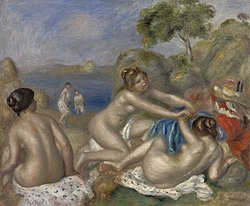Das Ding
The French psychoanalyst Jacques Lacan's exposition of sublimation is framed within a discussion about the relationship of psychoanalysis and ethics within the seventh book of his seminars. [17] Lacanian sublimation is defined with reference to the concept Das Ding (later in his career Lacan termed this objet petit a ); Das Ding is German for "the thing" though Lacan conceives it as an abstract notion and one of the defining characteristics of the human condition. Broadly speaking it is the vacuum one experiences as a human being and which one endeavours to fill with differing human relationships, objects and experiences, all of which are used to plug a gap in one's psychical needs. Unfortunately, all attempts to overcome the vacuity of Das Ding are insufficient in wholly satisfying the individual. For this reason, Lacan also considers Das Ding to be a non-Thing or vacuole. [18]
Lacan considers Das Ding a lost object ever in the process of being recuperated by Man. Temporarily the individual will be duped by his or her own psyche into believing that this object, this person or this circumstance can be relied upon to satisfy his needs in a stable and enduring manner when in fact it is in its nature that the object as such is lost—and will never be found again. Something is there while one waits for something better, or worse, but which one wants, [19] and again Das Ding "is to be found at most as something missed. One doesn't find it, but only its pleasurable associations." [19] Human life unravels as a series of detours in the quest for the lost object or the absolute Other of the individual: "The pleasure principle governs the search for the object and imposes detours which maintain the distance to Das Ding in relation to its end." [20]
Lacanian sublimation
Lacanian sublimation centres to a large part on the notion of Das Ding. His general formula for sublimation is that "it raises an object ... to the dignity of The Thing." [21] Lacan considers these objects (whether human, aesthetic, credal, or philosophical) to be signifiers which are representative of Das Ding and that "the function of the pleasure principle is, in effect, to lead the subject from signifier to signifier, by generating as many signifiers as are required to maintain at as low a level as possible the tension that regulates the whole functioning of the psychic apparatus." [22] Furthermore, man is the "artisan of his support system", [22] in other words, he creates or finds the signifiers which delude him into believing he has overcome the emptiness of Das Ding.
Lacan also considers sublimation to be a process of creation ex nihilo (creating out of nothing), [23] whereby an object, human or manufactured, comes to be defined in relation to the emptiness of Das Ding. Lacan's prime example of this is the courtly love of the troubadours and Minnesänger [21] who dedicated their poetic verse to a love-object which was not only unreachable (and therefore experienced as something missing) but whose existence and desirability also centered around a hole (the vagina). [24] For Lacan such courtly love was "a paradigm of sublimation." [25] He affirms that the word 'troubadour' is etymologically linked to the Provençal verb trobar (like the French trouver), "to find". [26] If we consider again the definition of Das Ding, it is dependent precisely on the expectation of the subject to re-find the lost object in the mistaken belief that it will continue to satisfy him (or her).
Lacan maintains that creation ex nihilo operates in other noteworthy fields as well. In pottery for example vases are created around an empty space. [27] They are primitive and even primordial artifacts which have benefited mankind not only in the capacity of utensils but also as metaphors of (cosmic) creation ex nihilo. Lacan cites Heidegger who situates the vase between the earthly (raising clay from the ground) and the ethereal (pointing upwards to receive). [28] In architecture, Lacan asserts, buildings are designed around an empty space and in art paintings proceed from an empty canvas, [29] and often depict empty spaces through perspective.
In myth, Pan pursues the nymph Syrinx who is transformed into hollow reeds in order to avoid the clutches of the god, who subsequently cuts the reeds down in anger and transforms them into what we today call panpipes (both reeds and panpipes rely on their hollowness for the production of sound). [24]
Lacan briefly remarks that religion and science are also based around emptiness. In regard to religion, Lacan refers the reader to Freud, stating that much obsessional religious behavior can be attributed to the avoidance of the primordial emptiness of Das Ding or in the respecting of it. [29] As for the discourse of science this is based on the notion of Verwerfung [30] (the German word for "dismissal") which results in the dismissing, foreclosing or exclusion of the notion of Das Ding presumably because it defies empirical categorisation.


